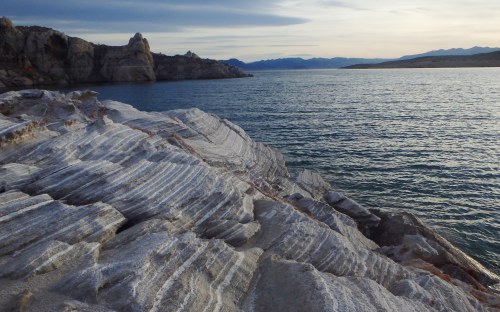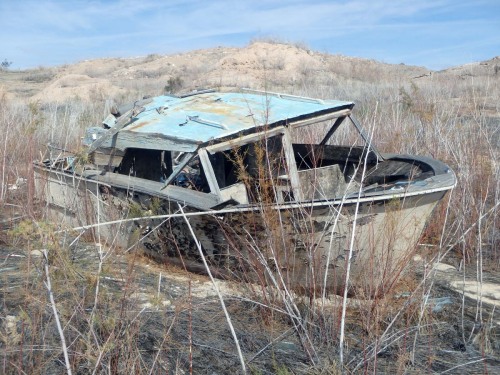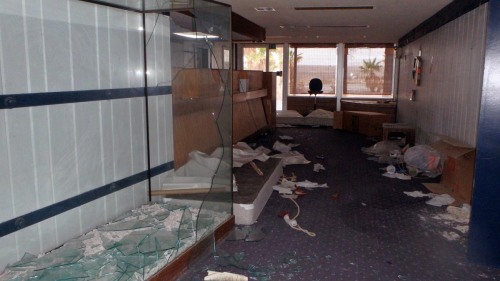
Lake Mead was established as America’s first National Recreation Area.
If we can save Lake Mead, we can save America. The issues that face Lake Mead, formed by Hoover Dam in 1935, are emblematic of the issues that face America. Water from the Colorado River, like the federal budget, is over-allocated. The deficit isn’t so much a lack of water coming in to the lake, but too much going out to water users in California, Arizona, and locally at Las Vegas, Nevada. The result is a permanent white bathtub ring 150 feet above the remaining lake, leaving an oversized dam, and decaying infrastructure throughout Lake Mead National Recreation Area. There is a potential solution to this slow-motion crisis, which can be found three hundred miles to the West.

Lake Mead is the closest place to Montana with palm trees, where a person can comfortably pitch a tent and camp in the middle of winter.
Lake Mead was established as America’s first National Recreation Area in 1936, originally named the Boulder Dam Recreation Area. Measured by capacity, Lake Mead is the largest reservoir in the United States, but water levels have fallen to 37 percent of capacity. Lake Mead National Recreation Area is administered by the National Park Service, similar to a national park, but with greater emphasis as an outdoor play area than on natural preservation.
Lake Mead has been slowly drying up since 1983. I first discovered the lake in the early 1990s on a winter trip from my home in Montana south to Arizona. Lake Mead is the closest place to home with palm trees, where one can comfortably pitch a tent and enjoy camping in mid-winter. If need be, I can drive the 822 miles from home to the campground at Echo Bay in one long day on the road. Back then it still looked mostly full, as if the white rim around the lake was due to seasonal fluctuations, rather than a cumulative drop.

Touring Hoover Dam with my boys back in 2008. The white bathtub ring in the background is much larger now.
For better or worse, Hoover Dam was constructed when America still had the vision and balls to dream big and tackle the impossible, in this case, the most challenging engineering project ever undertaken, temporarily diverting the Colorado and building a 726-foot dam to restrain the mighty river. 660 feet thick at the bottom and 45 feet thick at the top, the Hoover Dam required so much concrete that the core is still cooling down from the chemical reaction of cement and water nearly a century later. The entire job was completed in just five years with the aid of 5,000 workers.
Throughout American history, we were a nation of dreamers, from the founding of democracy to construction of the transcontinental railroads and the founding of Yellowstone as the first national park in our country and in the world. Inspired by the dream of America, oppressed peoples in the Netherlands, France, Ireland, Poland, and around the world rebelled against autocratic governments and founded democracies of their own, spreading freedom without American intervention beyond the inspiration of our existence.
Ditto for America’s parks. Author Wallace Stegner described our national parks as “America’s best idea,” an idea that inspired other nations to form similar parks to preserve their own national treasures for future generations. As part of our national parks system, Lake Mead is effectively one of our ambassadors to the world.

Every city should be surrounded by wilderness!
Lake Mead and Las Vegas is also a model for the interface between urban centers and wildlands. The city is uniquely surrounded by vast public lands and outdoor recreation opportunities, what former Secretary of the Interior Bruce Babbitt described as a “city in the wilderness.” Every person in Vegas is about a half hour drive from the middle of nowhere, where hiking, camping, and boating opportunities abound. Wouldn’t it be great if every city shared similar opportunities?
Despite proximity to town, Lake Mead is strangely deserted in winter. High temperatures hover from the mid-50s to the mid-60s in December and January, sometimes dipping down to the 40s, chilly, but not unlike camping in the mountains of Montana in summer. By February, temperatures often reach the mid-70s and the cottonwoods leaf out three full months ahead of spring at home. Still, the campgrounds are largely deserted as Las Vegans consider this winter.

Lake Mead is a great winter getaway, especially coming south from Montana.
The lake doesn’t get busy until spring break or later, when urbanites from Vegas to Phoenix to Los Angeles begin flocking to the lake to cool off and play in the water. That suits me just fine. I’m content to paddle around the lake in a canoe, enjoying the lack of noisy motorboats and the waves they leave in their wake that could potentially swamp a canoe.
I also enjoy hiking the park’s rugged backcountry before it gets too hot. Lake Mead is rich with wildlife from bighorn sheep and burrows to jackrabbits, roadrunners, and Wile E. Coyote. Unfortunately, the recreation area has taken on an increasingly apocalyptic look as water levels have dropped and facilities have deteriorated or been completely abandoned, mirroring a general decline across America.

As water levels fell, the National Park Service poured more concrete to extend the Echo Bay boat ramp, eventually becoming a one-third mile boat ramp to nowhere.
The Echo Bay Hotel was still a waterfront resort when I first visited Lake Mead. I savored ripe dates below a date palm on the west side of the building, wishing I could scale the tree to pick more. The boat ramp in front of the hotel provided easy access to the lake. Each time I returned, the lake was a little farther from the hotel, and the Park Service had poured more concrete, extending the initial board ramp downhill to catch up with the receding lake, ultimately becoming a one-third mile boat ramp to nowhere, terminating far from the present lakeshore.
The marina was also pushed farther out into the lake, requiring constant re-engineering of the facilities and ever-longer water pipes, electrical lines, and anchor cables. A quarter mile beyond the boat ramp, the marina was abandoned, and the Park Service plowed a mile-long dirt road from the hotel to access the remaining lake.

The Echo Bay hotel and marina were abandoned, contributing to a post-apocalyptic aura.
Not surprisingly, the hotel soon went out of business. Vandals broke the windows and destroyed the interior. Ditto for the abandoned marina. Yet neither place has found room in the budget for demolition and removal, presumably because the Park Service has prioritized chasing the lake to keep facilities functional, rather than cleaning up old messes. The race to migrate the marinas with the receding lake has left behind a litter trail of old docks, parts, cables, concrete blocks and tire anchors. Abandoned boats are surprisingly common in the old dead stands of tamarisk far above the present lake.
Some of my anti-establishment friends see the decline of Lake Mead as prophetic to the inevitable abandonment of Las Vegas and Phoenix, desert cities that shouldn’t exist, sustained by water restrained by a dam that shouldn’t have been built. We should blow up the damn dam and every other dam to allow rivers to flow wild and free and restore the healthy ecology and natural fisheries, they exclaim. This article isn’t about whether or not Hoover Dam should have been built, but as long as it exists, I believe we might as well use it. Besides, if the lake ceased to exist and Las Vegas dried up, all those people might move to Montana.

There are many abandoned boats in the dead and dying tamarisk around Lake Mead.
There are also people who cheer the decline of America. Civilization as we know it is not sustainable. We’ve paved over paradise, fracked the planet for consumable resources, and terrorized the world with warfare. They see the collapse of our nation as a necessary step in the path to sustainability, to restoring balance with nature. I see it a bit differently, since there are enough guns and ammo to turn our country into Syria and to wipe out all remaining wildlife for food. All our toxic chemicals would spill unchecked into surface and groundwaters—and best of all—our untended nuclear reactors would melt down and irradiate all life on the planet. Collapse is no longer a viable option. Saving America, and saving Lake Mead, seems like a much better plan.

Vandals broke windows and destroyed the inside of the inside of the Echo Bay hotel before it was boarded up to prevent further access.
The doomsayers do have a point though. America has overreached and become a world terror. Gone are the days when we were the most respected and admired nation on earth. Somewhere we transitioned from inspiring other nations to bombing them in the name of peace and democracy. In the latest round of democracy-or-else, we invested $5 trillion dollars a) to remove Saddam Hussein (whom we previously supported and armed against Iran), b) to fight Al-Qaeda and the Taliban (after originally arming and training Afghans to fight the Soviets), and c) to destroy ISIS (which was born in our own Army prisons and armed with American weapons left behind from tasks a and b). In terms of bang for the buck, we don’t have much to show for the investment. Invested differently, $5 trillion could have saved Lake Mead as well as most of America.

Being landlocked in the desert, Las Vegas is dependent on water from Lake Mead.
American infrastructure is declining, and Lake Mead is drying up. Due to falling water levels, Las Vegas invested $817 million to construct a new intake pipe to reach deeper into the lake, yet it too is in danger of becoming a straw to nowhere as lake levels continue to drop. The problem is that downstream water users claim too much of the Colorado’s flow, such that experts forecast that Lake Mead will never rise to capacity again. At this point, I haven’t heard of a plan, a vision, or apparently even a discussion on how to remedy the problem. As a country, we lack the dream or the initiative to tackle our most basic problems.
Being landlocked in the desert, Las Vegas and Phoenix depend on the Colorado for their very survival. Farmers in California’s Central Valley also depend on the river to grow much of the nation’s produce. Los Angeles and San Diego, however, are situated adjacent to the world’s biggest bowl of water, the Pacific Ocean, three hundred miles west of Lake Mead. If these urban centers obtained their water from the ocean and left Colorado water in Lake Mead, the lake would refill at the rate of about 4 percent per year, enough to eventually fill the lake to capacity and potentially restore partial flows across the Mexico border to the Gulf of California.

Investing in desalinization to provide water to Los Angeles and San Diego from the Pacific Ocean could save enough Colorado River water to refill Lake Mead.
At present, desalinization is considered energy-intensive and cost prohibitive, about $2.20 to $5.00 per thousand cubic feet of treated water, compared to $2.00 to purify river water. Yet, the cost of desalinization is falling as other countries, notably Israel, invest heavily in the technology. The cost of wind, solar, and wave power are also falling, making desalinization a realistic possibility, if not now, then in the near future. The federal government and all water users would have to work together to determine who would pay for construction and operation of the desalinization plants.
Notably, Carlsbad, California has recently completed a desalinization plant to augment their water supply, and other plants are being discussed in the state, but apparently not towards the goal of restoring Lake Mead or guaranteeing future water supplies to Las Vegas and Phoenix.
Due to the 1922 Colorado River Compact governing water use, any water saved on the California coast would likely be utilized by other entities to fulfill their own claims. This is not an insurmountable problem. The effort required to renegotiate the water compact and build desalinization plants is far less than the bold action initially required to build the dam and create the lake.
Lake Mead needs what America needs, a bold vision for a better future and the gumption to commit to making it happen. If we can save Lake Mead, we can just as easily save America and once again become an inspiration and positive role model to the world.
 Thomas J. Elpel is the director of Green University, LLC in Pony, Montana and the author of numerous books on wilderness survival, nature, and sustainable living. In 2006, Thomas Elpel and friends paddled the Virgin River from Mesquite, Nevada downstream to Lake Mead… dragging canoes ten miles through the sand. Read the full story.
Thomas J. Elpel is the director of Green University, LLC in Pony, Montana and the author of numerous books on wilderness survival, nature, and sustainable living. In 2006, Thomas Elpel and friends paddled the Virgin River from Mesquite, Nevada downstream to Lake Mead… dragging canoes ten miles through the sand. Read the full story.

 Thomas J. Elpel Personal Website
Thomas J. Elpel Personal Website